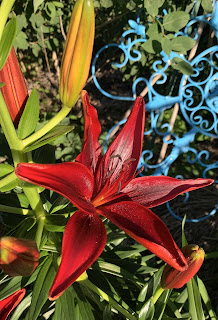These are the days when ProfessorRoush stumbles out each morning and is dazzled by the sight of his tall, statuesque Oriental and Orientpet lilies, lured to them around the corner of the garage by their strong fragrance carried on the morning breeze. My daily first chore of letting Bella out and making sure she attends to her business away from the house is much more pleasant while the lilies are in bloom.
The Orientpets and Orientals and Trumpet lilies bloom with the daylilies here, temporarily stealing the show from their more diminutive cousins, the former groups taller, larger, more fragrant, and simply more voluptuous than the latter. One can look into these bountiful blossoms and lose oneself in their perfection as they open. Lost too, you can become, if you breathe in that heavy perfume too deeply; it is overwhelming up close and cloying and some say almost sickening. I myself enjoy the fragrance of Oriental lilies and Orientpets outside where it is diluted by flowing air, but one blossom inside a room can be too much for me.
I think of all these lilies pictured here as Orientpet lilies, but, in fact they're not. 'Yellow Dream', prevalent in the picture below, is just a tall and tough Oriental lily, while 'Purple Prince', pictured above, is a bonafide Orientpet cross. The pure white lily here is perhaps an Oriental whose name I've lost, but I also have some "Lily Regale Album', a mostly white Chinese Trumpet lily with a very light yellow throat.
.jpg) |
| 'Yellow Dream' |
As I view these lilies, I feel only sorrow for the unimaginative breeders who chose the name "Orientpet" for these crosses between Oriental and Chinese Trumpet lilies. Viewing them, one wants a better name, more memorable, more intense. Offhand, however, I can't do any better. "Marvelous Lilies", "Wondrous Lilies," Astounding Lilies" and just plain "Gosh Wow Lilies" are the best I could think of.
.jpg) They're here and they're gone, fabulous flowers fading, browning and dropping and then the dark green foliage become merely a backdrop for the daylilies that outlast them. Thankfully, they're nearly trouble free here in Kansas, untouched by disease, left alone by rabbits and beetles, and viewed as a moderate delicacy only by brave deer. In my front yard, near the house, they're safe, but in the far beds of my yard the buds are eaten before they bloom.
They're here and they're gone, fabulous flowers fading, browning and dropping and then the dark green foliage become merely a backdrop for the daylilies that outlast them. Thankfully, they're nearly trouble free here in Kansas, untouched by disease, left alone by rabbits and beetles, and viewed as a moderate delicacy only by brave deer. In my front yard, near the house, they're safe, but in the far beds of my yard the buds are eaten before they bloom.What I need more of, perhaps, are 'Kaveri', which seems to be one of the least troublesome of all the bulbs I grow. I'm still not crazy about the brash colors of this Asiatic and Oriental lily cross, but it has proliferated on its own and maintains a presence in my backyard even in the shade of a volunteer Redbud. I'll give the glaring red-orange-yellow a pass, lighting up the shade as it does, but it still lacks the fragrance and elegance of Orientals and some "Gosh Wow" Orientpets.
Maybe, just maybe, I also should be less picky and more thankful for what survives the Kansas climate.

.jpg)
.jpg)


.jpg)
.jpg)
.jpg)
.jpg)
























